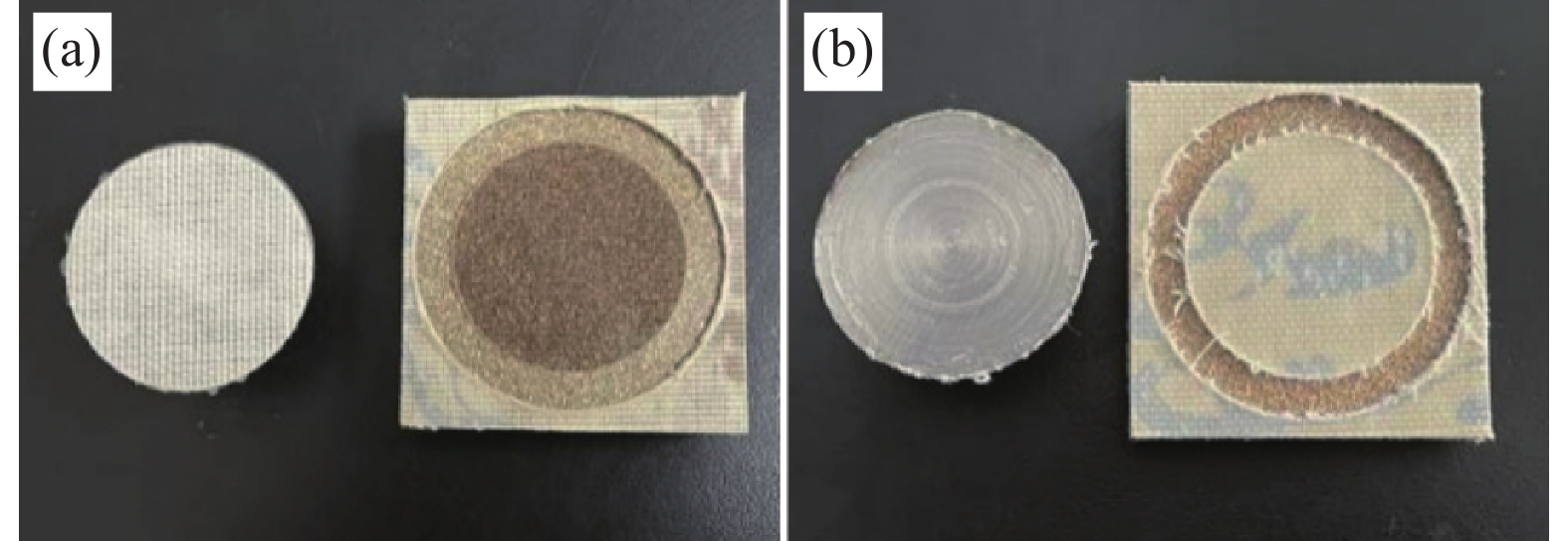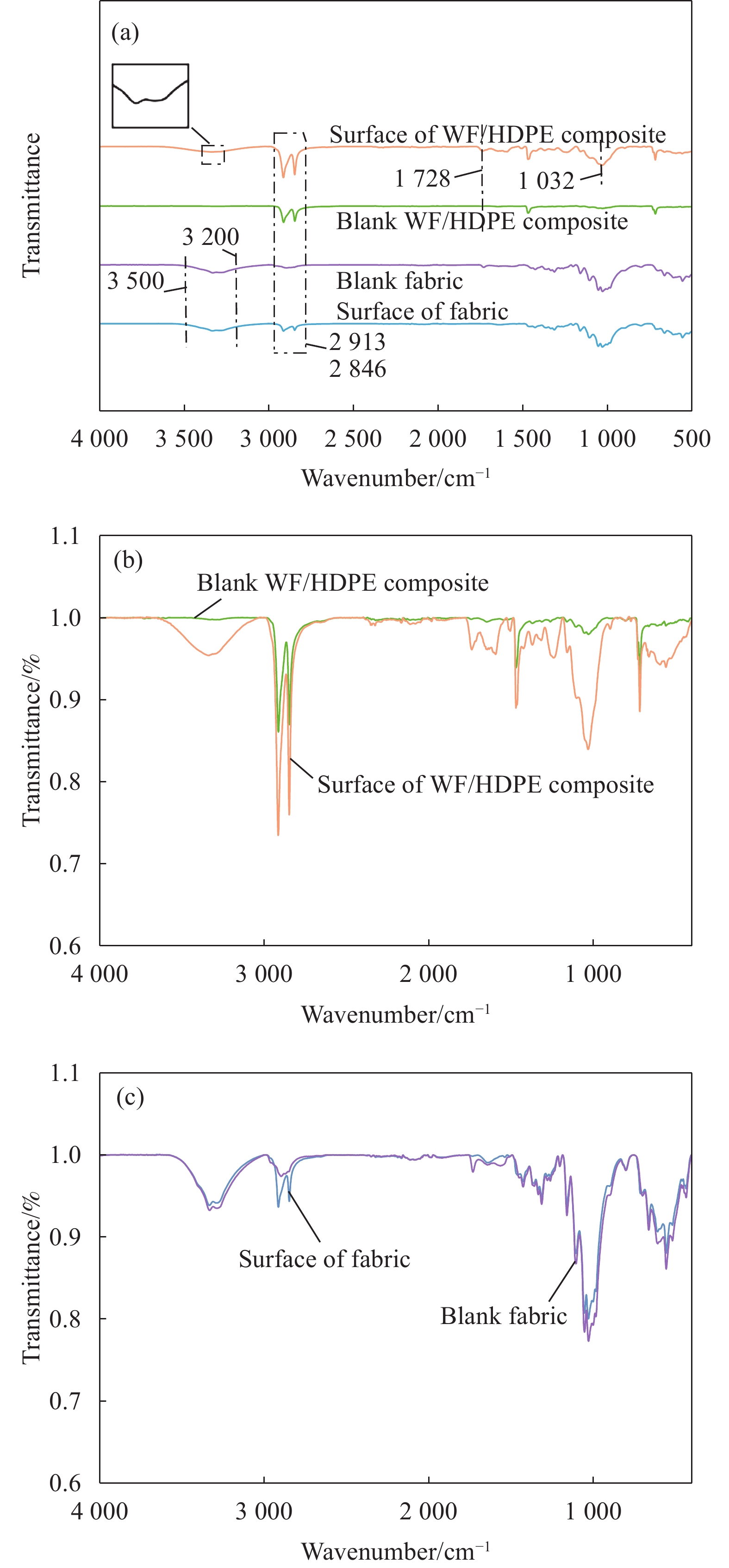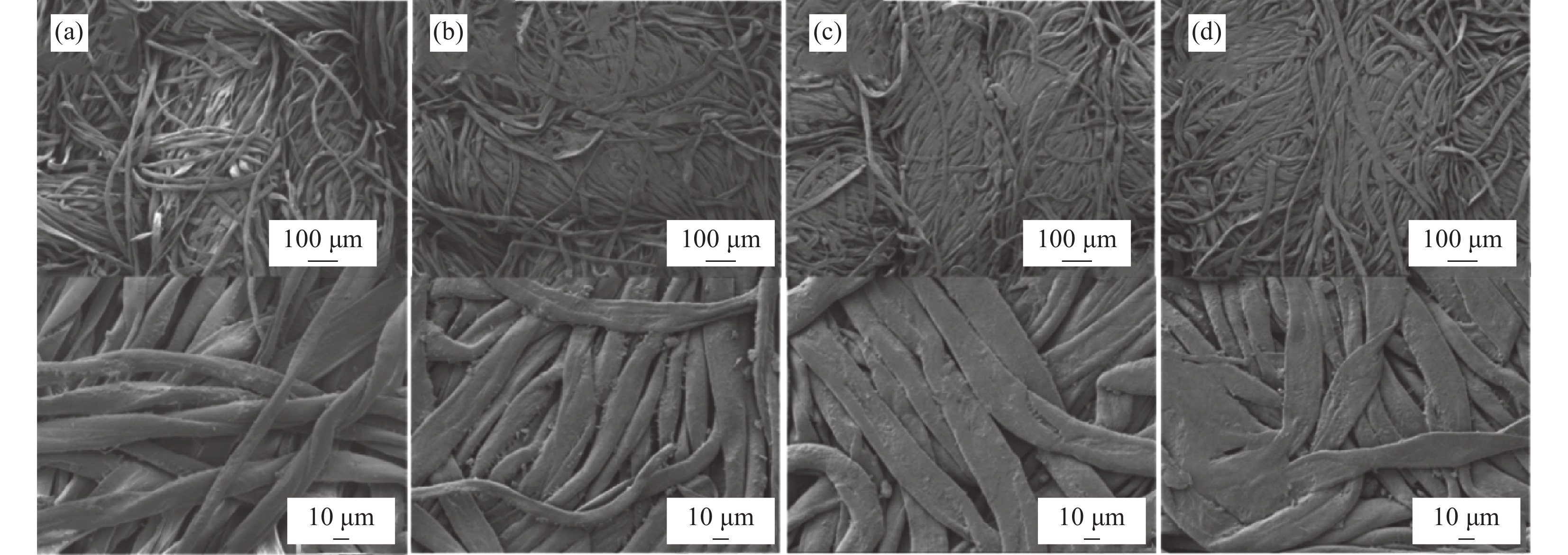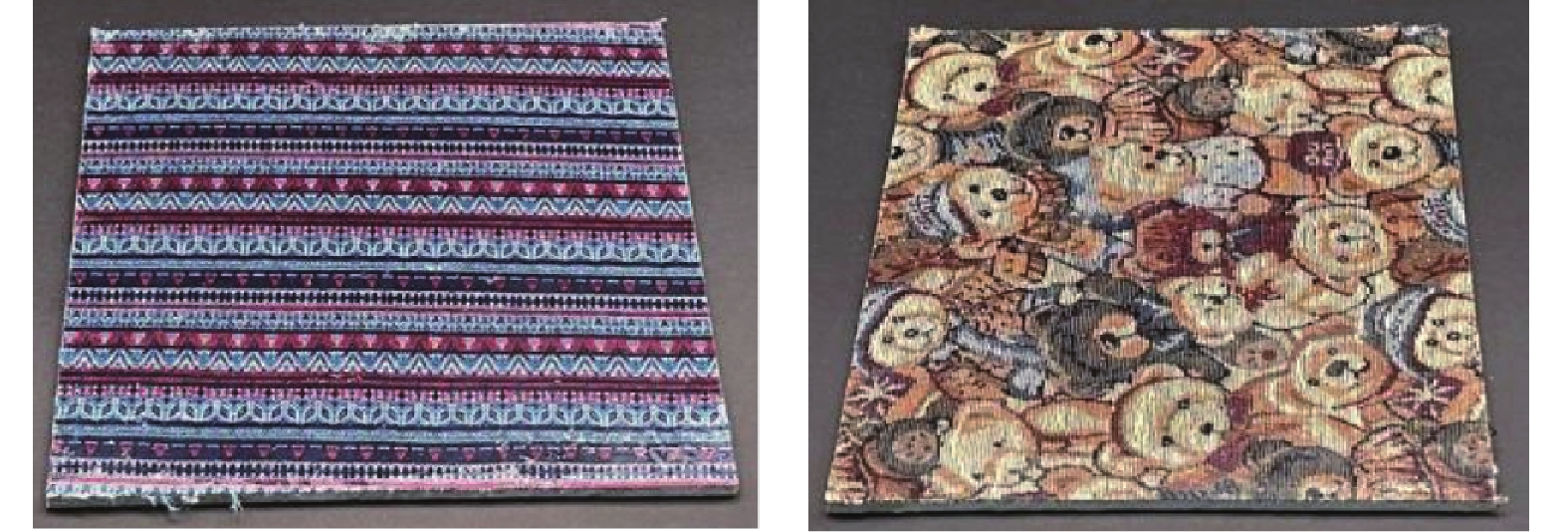Preparation and performance of fabric decorative wood plastic composites
-
摘要: 利用织物装饰木塑复合材料风格多变,能够大大提高木塑复合材料的实用价值。本文开发了一种新型装饰织物贴面技术,将热塑性聚合物铺设在装饰织物表面,与热压板直接接触,从而缩短装饰织物承受高温的时间;并且受热熔化的聚合物透过装饰织物与木塑基材表面的聚合物相熔合,起到固定和保护装饰织物的作用。本文探究了热压温度(140℃、160℃和180℃)、基材中木塑比(6∶4、7∶3和8∶2)和表面聚合物的种类(高密度聚乙烯、低密度聚乙烯和聚乳酸)对饰面木粉/高密度聚乙烯(WF/HDPE)复合材料表面胶合强度、装饰效果、力学性能等的影响;通过红外光谱、扫描电子显微镜等手段对WF/HDPE复合材料和织物的性能变化进行了分析和表征。结果表明:熔融的聚合物能够透过装饰织物纤维空隙,与木塑基材熔合状况良好,制得的装饰复合材料表面光滑平整。综合分析热压温度、基材木塑比和表面聚合物种类的影响,认为当热压温度为160℃、木塑比为7∶3时,表层使用聚乳酸时棉麻织物装饰的WF/HDPE复合基材力学强度最佳,表面胶合强度可达3.64 MPa,弯曲强度达到82.19 MPa。Abstract: The use of fabrics to decorate wood plastic composites (WPC) in a variety of styles can greatly improve the practical value of WPC. In this study, a new decorative fabric veneer technique was developed, in which a thermoplastic polymer was laid on the surface of the decorative fabric. This enabled the thermoplastic polymer to be in direct contact with the hot platen, thus shortening the time that the decorative fabric was exposed to high temperatures. Moreover, the heat-melted polymer fused with the polymer on the surface of the wood-plastic substrate through the decorative fabric, which served to fix and protect the decorative fabric. In this paper, the effects of hot-pressing temperature (140℃, 160℃ and 180℃), wood-plastic ratio in the substrate (6∶4, 7∶3 and 8∶2) and the type of polymer (high density polyethylene, low density polyethylene and polylactic acid (PLA)) on the properties, such as surface bonding strength, decorative effect and mechanical properties of the decorative wood flour/high-density polyethylene (WF/HDPE) composites, were investigated. The changes in the properties of WF/HDPE composites and fabrics were analyzed and characterized by FTIR and SEM. The results show that the molten polymer is able to pass through the fiber voids of the decorative fabric and fuses well with the wood-plastic substrate. The surface of the produced decorative composite material is smooth and even. The effects of hot pressing temperature, substrate wood-plastic ratio and surface polymer type were comprehensive analyzed. When the hot pressing temperature is 160℃, wood-plastic ratio is 7∶3, the mechanical strength of the WF/HDPE composite substrate with the surface layer of the fabric decorated with PLA is the best. Its surface bonding strength is up to 3.64 MPa and the bending strength reaches 82.19 MPa.
-
糖尿病是一种严重威胁人类健康的慢性病。全球糖尿病患者人数从1980年的1.08亿增加到2023年的5.37亿。葡萄糖传感器在糖尿病的诊断和治疗中起着重要作用[1-3]。糖尿病患者要定期检测生理血糖水平,并将血糖水平维持在正常浓度范围内。而且,准确评价食品中的葡萄糖含量对维持糖尿病患者血液中葡萄糖的生理水平至关重要[4-5]。食品和饮料中葡萄糖含量的信息对生产者和消费者都有参考价值。葡萄糖检测在葡萄酒酿造工艺和乳制品工业的发酵过程中是至关重要的[4-5]。迄今为止,检测葡萄糖的方法很多。在各种分析方法中,电化学葡萄糖传感器具有灵敏度高、选择性好、操作简单、成本低等优点,并能实现自我监控和床边血糖检测[5-8]。基于酶的电化学葡萄糖传感器已经商业化并取得了巨大的成功。由于自然酶容易受到环境(温度、湿度、酸碱度等)影响,非酶葡萄糖传感器受到广泛关注[1-3, 8]。
金属-有机框架(Metal-origanic frameworks,MOFs)材料是一类新兴的多孔材料,存在电化学传感器应用潜力[9-12]。它们具有金属活性位点丰富、表面积大、结构多样、孔径可调和功能可调等优点。Li等[13]开发了Co-MOF纳米片阵列构建葡萄糖检测平台,其灵敏度为
10886 μA·L/(mmol·cm2),检测极限为1.3 nmol/L。Khan等[14]以MOF-199为前驱体合成 CuO/C复合材料,催化葡萄糖的氧化反应。Cu-MOFs修饰电极在0.06至5 mmol/L的线性范围内,对葡萄糖氧化显示出相对较好的电催化活性,其灵敏度为89 mA·L/(mmol·cm2),检测限为10.5 nmol/L。在另一份报告中,球形Ni-MOFs 颗粒在单独使用时表现出较差的电化学葡萄糖传感性能[15]。然而,当它们与碳纳米管的杂交后,对葡萄糖检测的灵敏度为13.85 mA·L/(mmol·cm2),检测极限为0.82 mmol/L,线性范围为1至1.6 mmol/L。此外,Zha等[16]开发了基于NiCo-MOF/C复合材料的无创血糖检测平台,其高灵敏度和检测极限分别为2701.29 μA·L/(mmol·cm2)和0.09 μmol/L。MOFs衍生复合材料在电化学葡糖糖传感器领域得到一定程度的应用。另一方面,随着实时传感设备和护理点设备的发展需要,经济的、可靠的、规模化的电极制备方法受到广泛关注[17]。作为一种商业化电极制备方法,丝网印刷技术具有设备简单、图案设计灵活、操作简单、经济等特点[17]。该技术在生物传感器领域,尤其指尖血糖检测中取得商业成功。Li等[18]实验组通过丝网印刷技术开发了一种具有优化三电极配置的多功能电化学平台,检测葡萄糖浓度。Ji等[19]实验组基于智能手机的循环伏安系统,采用石墨烯修饰的丝网印刷电极检测葡萄糖浓度。因此,本文在室温条件合成Co基MOFs(Co-ZIF-67),采用丝网印刷技术,制备了Co-ZIF-67修饰的商业银-碳电极,研究其对葡萄糖的传感性能。
1. 实验方法
1.1 原材料与试剂
六水硝酸钴(Co(NO3)2·6H2O,99.5%) 、聚乙烯醇(PVA,92%~94%)、聚乙烯吡咯烷酮(PVP,K23-27)、甲醇(CH2OH,99.5%)、3-(N-吗啉)丙磺酸钠(MOPs-Na,C7H14NO4SNa,99.5%)、羟乙基纤维素(HEC)、丙烯酰胺(C3H5NO,99.0%)、抗坏血酸(C6H6O8,99.0%)、半乳糖(C6H12O6,99.0%)、羧甲基纤维素((C6+2yH7+x+2yO2+x+3yNay)n)、柠檬酸(C6H8O7,99.5%)、葡萄糖(C6H12O6,96%)和葡聚糖(DEAE-Dextran,70 kDa)购自上海阿拉丁生化科技股份有限公司。过硫酸铵(H8N2O8S2,98.5%)购自上海麦克林生化科技有限公司。
1.2 材料表征
采用X-射线衍射仪(Smartlab9kw,Rigaku)对样品的物相和晶体结构进行表征。通过X射线光电子能谱(ESCALAB 250Xi,赛默飞)对样品的元素和表面信息进行分析。采用扫描电子显微镜扫描电镜(SEM,SU8100,日立)和透射电子显微镜(TEM,JEM2100,JEOL)对样品进行形貌表征。通过电化学工作站(CH650E,上海辰华仪器有限公司)评估修饰电极对葡萄糖的电化学传感性能。本研究配制了不同浓度葡萄糖(0.1~0.5 mmol/L)的0.1 mol/L氢氧化钠溶液。
1.3 Co-ZIF-67及Co-ZIF-67修饰电极的制备
Co-ZIF-67纳米材料在室温条件下制备而成。合成过程中,12 mmol/L的Co(NO3)2·6H2O完全溶解于100 mL甲醇中,记为溶液 A;48 mmol/L的2-甲基咪唑溶解于
1000 mL甲醇中,记为溶液 B。溶液B迅速地加入到溶液A中,形成混合液C。该混合液C磁力搅拌10 min后,在室温环境下静置24 h,形成沉淀物。采用甲醇清洗沉淀物,并在60℃干燥过夜,得到紫色Co-ZIF-67粉末。把20 mg Co-ZIF-67在1 mL的超纯水中超声30 min,得到溶液D。0.55 g MOPs 钠盐,0.075 g的羟乙基纤维素,1.75 g丙烯酰胺和0.05 g过硫酸铵分别溶解于25 mL的超纯水中,磁力搅拌2 h后形成混合浆料。将1 mL溶液D与9 mL浆料磁性搅拌1 h后,形成 Co-ZIF-67丝网印刷油墨。
将Co-ZIF-67油墨均匀的丝网印刷在商业银-碳电极的工作区域,经烘干(45℃,15 min)、贴亲水膜、裁剪,制备了便携式一次性条形葡萄糖检测电极。该电极包括一个工作电极,一个对电极。工作电极的表面积为3.78 mm×0.252 mm=
0.9526 mm2。每个电极所分析的溶液量为10 μL。亲水膜的作用是形成流道,吸附检测样品。Co-MOF修饰电极的制备过程见图1。2. 结果与讨论
2.1 Co-ZIF-67物相分析
采用XRD技术研究了Co-ZIF-67的晶体结构。从图2(a)可以看出,在2θ=10.4°、12.7°、14.7°、16.4°、18.0°、22.1°、24.4°、26.5°、29.8°、30.5°和32.5°时,分别对应于ZIF-67的(002)、(112)、(022)、(013)、(222)、(114)、(233)、(134)、(044)、(244)、(235)晶面,这与已报道的ZIF-67样品的XRD结果一致[20-22]。采用X射线光电子能谱(XPS)对Co-ZIF-67的表面信息进行了分析。从图2(b)可以看出,样品包含Co2p、O1s、N1s、C1s、Co3s和Co3p核能级区域。Co2p和 C1s的XPS精细谱分别如图2(c)和图2(d)所示。Co2p精细谱含有两个主峰,其中780.1 eV峰来自Co2p3/2;795.3 eV峰来自Co2p1/2。激振峰分别位于785.5和801.7 eV。除了主峰,C1s精细谱还有两个拟合峰。结合能位于286.2和288.1 eV,分别归属于C—N和C—O。上述结果表明,Co-ZIF-67已经被成功制备。采用SEM和TEM研究了样品的形貌。如图3(a)~3(f)所示,Co-ZIF-67呈现多面形,且尺寸分布相对较窄。
2.2 Co-ZIF-67的电催化性能
采用循环伏安(CV)技术评估了Co-ZIF-67修饰电极的电化学性能。图4(a)是Co-ZIF-67修饰电极在50 mV/s扫速时对0.3 mmol/L葡萄糖在不同pH值溶液中的响应信号。很明显,当pH=13时,Co-ZIF-67表现出对葡萄糖较大的催化活性。当葡萄糖浓度增加时,Co-ZIF-67修饰电极电流信号也随之增强(图4(b))。然而,信号的区分度不大。图4(c)是Co-ZIF-67修饰电极在不同扫速(10、30、50、70、90、110和130 mV/s)下对葡萄糖信号的变化。随着扫速增大,电流信号明显得到加强。将0.5 V电流强度与扫描速度的算术平方根进行拟合,其线性关系为:I (μA/cm2)=0.14v1/2–0.12 (R2=0.988,R2为决定系数)。这说明Co-ZIF-67修饰电极对应的电化学反应是受扩散控制的[23]。
![]() 图 4 Co-ZIF-67修饰电极在不同pH值(a)、葡萄糖浓度(b)、扫速(c)对葡萄糖的CV测试曲线;(d)扫描速率(v)的算数平方根与电流(I) (0.5 V)之间的线性关系Figure 4. CV curves of Co-ZIF-67 modified electrodes with different pH (a), glucose concentrations (b), and scan rates (c); (d) Corresponding linear relationship between the arithmetic square root of the scanning rate (v) and current (I, 0.5 V)R2—The coefficient of determination, which determinates the linear relationship of the fit curve
图 4 Co-ZIF-67修饰电极在不同pH值(a)、葡萄糖浓度(b)、扫速(c)对葡萄糖的CV测试曲线;(d)扫描速率(v)的算数平方根与电流(I) (0.5 V)之间的线性关系Figure 4. CV curves of Co-ZIF-67 modified electrodes with different pH (a), glucose concentrations (b), and scan rates (c); (d) Corresponding linear relationship between the arithmetic square root of the scanning rate (v) and current (I, 0.5 V)R2—The coefficient of determination, which determinates the linear relationship of the fit curve采用差分脉冲伏安法(Differential pulse voltammetry,DPV)进一步评估了Co-ZIF-67修饰电极的电化学性能。如图5(a)所示,在0~0.5 mmol/L 葡萄糖溶液中观测了Co-ZIF-67修饰电极表面的氧化和还原反应,其对葡萄糖可能的催化机制为:Co-ZIF-67修饰电极对葡萄糖表现出较CV更强的DPV响应信号,这也表明,Co-ZIF-67对葡萄糖确实存在电催化效果[24-27]。此外,溶液中没有葡萄糖时,Co-ZIF-67修饰电极在0.4~0.6 V有一个不明显的氧化还原峰。随着葡萄糖浓度的增加,该修饰电极的响应信号也随之增强,氧化还原峰变得更加明显,这主要是由于高电位下碱性溶液中Co-ZIF-67中Co2+被氧化为Co3+。此时,Co3+因从葡萄糖得电子(变为Co2+)并不断将葡萄糖氧化为葡萄糖酸从而产生电流信号[28-29]。因此,Co-ZIF-67修饰电极具有较好的电催化性能。如图5(b)所示,Co-ZIF-67修饰电极的电流平均值(0.55 V)与葡萄糖浓度呈线性关系,其线性方程为:I (μA/cm2)=−3.730×C(mmol/L) − 5.720 (R2=
0.9639 )。![]() 图 5 (a) Co-ZIF-67修饰电极在不同葡萄糖浓度中的差分脉冲伏安法(DPV)测试曲线;(b)每5支Co-ZIF-67修饰电极在0.55 V电位对不同浓度葡萄糖的平均电流响应信号;(c) Co-ZIF-67修饰电极对不同葡萄糖浓度的安培响应;(d)每5支电极对不同葡萄糖浓度的平均响应电流(取第15 s数值)Figure 5. (a) Differential pulse voltammetry (DPV) curves of Co-ZIF-67 modified electrodes in the presence of glucose; (b) Linear relationship between average DPV current density response and different glucose concentrations of every five electrodes at 0.55 V; (c) Amperometric response of Co-ZIF-67 modified SPEs to different glucose concentration; (d) Corresponding linear curve of average current density of five electrodes in the 15th s to glucose concentrations
图 5 (a) Co-ZIF-67修饰电极在不同葡萄糖浓度中的差分脉冲伏安法(DPV)测试曲线;(b)每5支Co-ZIF-67修饰电极在0.55 V电位对不同浓度葡萄糖的平均电流响应信号;(c) Co-ZIF-67修饰电极对不同葡萄糖浓度的安培响应;(d)每5支电极对不同葡萄糖浓度的平均响应电流(取第15 s数值)Figure 5. (a) Differential pulse voltammetry (DPV) curves of Co-ZIF-67 modified electrodes in the presence of glucose; (b) Linear relationship between average DPV current density response and different glucose concentrations of every five electrodes at 0.55 V; (c) Amperometric response of Co-ZIF-67 modified SPEs to different glucose concentration; (d) Corresponding linear curve of average current density of five electrodes in the 15th s to glucose concentrations采用安培响应技术在Co-ZIF-67修饰电极上对葡萄糖的传感性能做了进一步的评估。图5(c)显示随着电解质溶液中葡萄糖浓度的增加,响应电流随之增强。安培响应电流与葡萄糖浓度之间呈线性关系(图5(d)),其方程为:I (μA/cm2)=−1.390×C(mmol/L)−2.630 (R2=
0.9504 )。经过处理,Co-ZIF-67修饰电极对葡萄糖的检测灵敏度为1390 nA·L/(mmol·cm2),检测限为0.58 μmol/L (S/N=3),线性范围为0.1~0.5 mmol/L。值得一提的是,与已报道的电极相比,Co-ZIF-67修饰电极的灵敏度具有较大的优势,如表1所示[27, 29-34]。表 1 Co-ZIF-67修饰电极及其他电极的葡萄糖传感性能Table 1. Glucose sensing performance of Co-ZIF-67-modified electrodes and other previously reported electrodesType of electrode Sensitivity/(μA·L·mmol−1·cm−2) Detection limit/(μmol·L−1) Linear range/(mmol·L−1) Ref. Ag NPs/MOF-74(Ni) 1290 4.7 0.01-4 [27] NF/NiCo2O4 NWs@Co3O4 NPs 8163.2 – 0.001-1.7 [29] CuCo-MOF 6861 0.12 – [30] Ni2Co1-BDC/GCE 3925.3 0.29 0.0005 -2.8995 [31] Ni/Co(HHTP)MOF/CC 3250 0.1 0.0003 -2.312[32] MIL-88A@NiFe-PB 1963.2 0.12 0.005-1 [33] Ni3(HHTP)2/CNT 4774 4.1 0.004-3.9 [34] Co-MOFs/SPEs 1.393 0.58 0.1-0.5 This work Notes: CC—Carbon cloth; BDC—1, 4-benzenedicarboxylic acid; GCE—Glassy carbon electrode; HHTP—2, 3, 6, 7, 10, 11-hexahydroxytriphenylene; MIL—Materials from Institute Lavoisier; PB—Prussian blue; CNT—Carbon nanotubes; NF—Nickel foam; NWs—Nanowires; NPs—Nanoparticles; SPEs—Screen-printing electrodes. 2.3 抗干扰性、稳定性和重现性
图6(a)描述了Co-ZIF-67修饰电极抗干扰性能。从图上可以看出,干扰物质抗坏血酸(AA,3 mmol/L)、艾考糊精(INN,0.164 mol/L)、半乳糖(GAL,8 mmol/L)、谷胱甘肽(GSH,30 mmol/L)、麦芽糖(MAL,0.584 mol/L)引起的响应电流变化分别为−3.9%、−14.3%、−19.3%、−14.6%和−8.4%。与干扰物质相比,滴加0.1 mmol/L葡萄糖溶液时电流响应的显著变化表明。因此,Co-ZIF-67修饰电极具有较强的抗干扰能力。随后,通过长时间空气存放观察Co-ZIF-67修饰电极对0.1 mmol/L 葡萄糖的电流响应来评估的其稳定性。如图6(b)所示,Co-ZIF-67修饰电极表现出良好的稳定性。16天后,该电极仍然具有96%的初始响应。重现性是对电极的一个重要衡量标准。如图6(c)所示,Co-ZIF-67修饰电极的相对标准方差(Relative standard deviation,RSD)仅为10%,这说明该电极具有较好的重现性。
![]() 图 6 (a)干扰检查:5支Co-ZIF-67修饰电极 对0.1 mmol/L 葡萄糖(GLU)、0.164 mol/L 艾考糊精(INN)、9 mmol/L 半乳糖(GAL)、30 mmol/L谷胱甘肽(GSH)和0.584 mol/L 麦芽糖(MAL) 的平均安培响应;(b)稳定性:每5支Co-ZIF-67修饰电极在第1 d、4 d、7 d、10 d、13 d和16 d内对0.1 mmol/L 葡萄糖的安培响应信号;(c)重现性:10支Co-ZIP-67修饰电极对0.1 mmol/L 葡萄糖的响应Figure 6. (a) Interference examination: Average amperometric responses of five CuO nanomaterials modified SPEs to 0.1 mmol/L glucose (GLU), 0.164 mol/L alcodextrin (INN), 9 mmol/L galactose (GAL), 30 mmol/L glutathione (GSH) and 0.584 mol/L maltose (MAL); (b) Stability of every 5 Co-ZIF-67 modified electrodes to 0.1 mmol/L glucose on the 1st, 4th, 7th, 10th, 13th and 16th days; (c) Reproducibility of Co-ZIF-67 modified electrodes to 0.1 mmol/L glucose
图 6 (a)干扰检查:5支Co-ZIF-67修饰电极 对0.1 mmol/L 葡萄糖(GLU)、0.164 mol/L 艾考糊精(INN)、9 mmol/L 半乳糖(GAL)、30 mmol/L谷胱甘肽(GSH)和0.584 mol/L 麦芽糖(MAL) 的平均安培响应;(b)稳定性:每5支Co-ZIF-67修饰电极在第1 d、4 d、7 d、10 d、13 d和16 d内对0.1 mmol/L 葡萄糖的安培响应信号;(c)重现性:10支Co-ZIP-67修饰电极对0.1 mmol/L 葡萄糖的响应Figure 6. (a) Interference examination: Average amperometric responses of five CuO nanomaterials modified SPEs to 0.1 mmol/L glucose (GLU), 0.164 mol/L alcodextrin (INN), 9 mmol/L galactose (GAL), 30 mmol/L glutathione (GSH) and 0.584 mol/L maltose (MAL); (b) Stability of every 5 Co-ZIF-67 modified electrodes to 0.1 mmol/L glucose on the 1st, 4th, 7th, 10th, 13th and 16th days; (c) Reproducibility of Co-ZIF-67 modified electrodes to 0.1 mmol/L glucose2.4 血清测试
为了研究Co-ZIF-67修饰电极在实际样品中检测葡萄糖的性能,我们进行了加标回收实验(拜安进血糖仪(拜安进血糖试纸(葡萄糖脱氢酶),拜耳公司))。将血清稀释在NaOH溶液中,血清浓度为0.12 mmol/L。如表2所示,葡萄糖的回收率在93.97%~101.5%,RSD小于6.2%。这也表明Co-ZIF-67修饰电极具有潜在应用。
表 2 Co-ZIF-67修饰的Ag-C电极检测血清样品的葡萄糖含量(n=3)Table 2. Glucose detection in human serum samples using Co-ZIF-67 modified Ag-C electrodes (n=3)Sample Serum glucose/(mmol·L−1) Added glucose/(mmol·L−1) Detected glucose/(mmol·L−1) RSD/% Recovery rate/% Human
serum0.12 0.18 0.29 6.20 93.97 0.28 0.39 4.37 101.5 0.36 0.47 3.90 98.97 Note: RSD—Relative standard deviation. 3. 结 论
(1)基于室温合成的Co-ZIF-67,采用丝网印刷技术批量构建了Co-ZIF-67修饰的商业银-碳电极。
(2) Co-ZIF-67修饰电极表现出优异的葡萄糖电催化性能:0.58 μmol/L的检测极限,1.393 μA·L/(mmol·cm2)的灵敏度,高的抗干扰性,96%的空气稳定性。
(3)研究表明,Co-ZIF-67的低能耗合成及其Co-ZIF-67修饰电极的批量化制备为葡萄糖传感器的发展提供一个可参考的方向。
-
表 1 织物贴面木粉/高密度聚乙烯(WF/HDPE)复合材料的压制条件
Table 1 Pressing conditions of fabric decorated wood flour/high-density polyethylene (WF/HDPE) composites
Pre-pressing temperature
/℃Pre-pressing duration
/minPre-pressing pressure
/MPaHot-pressing temperature
/℃Hot-pressing duration/min Hot-pressing pressure/MPa Cold-pressing pressure/MPa 140/160/180 2 0.5 140/160/180 1 1.5 1.5 表 2 因素和水平表
Table 2 Table of factors and levels
Level Factor A B C 1 140 6∶4 HDPE 2 160 7∶3 LDPE 3 180 8∶2 PLA Notes: A is the hot-pressing temperature (℃); B is the ratio of WF to HDPE of substrate; C is the type of polymer on fabric; LDPE—Low density polyethylene; PLA—Polylactic acid. 表 3 织物贴面WF/HDPE复合材料热压工艺方案
Table 3 Schemes of hot-pressing process of fabric decorated WF/HDPE composites
No. A B C Level Value Level Value Level Type 1 A1 140 B1 6∶4 C1 HDPE 2 A1 140 B2 7∶3 C2 LDPE 3 A1 140 B3 8∶2 C3 PLA 4 A2 160 B1 6∶4 C2 LDPE 5 A2 160 B2 7∶3 C3 PLA 6 A2 160 B3 8∶2 C1 HDPE 7 A3 180 B1 6∶4 C3 PLA 8 A3 180 B2 7∶3 C1 HDPE 9 A3 180 B3 8∶2 C2 LDPE 表 4 织物贴面WF/HDPE复合材料的表面胶合强度和浸渍剥离长度测试结果
Table 4 Surface bonding strength and impregnation/stripping length of fabric decorated WF/HDPE composites
No. Surface bonding strength/MPa Length of impregnation and peeling/mm 1 2.76±0.32 0 2 2.98±0.33 0 3 1.67±0.37 0 4 4.46±0.61 0 5 3.64±0.68 0 6 3.68±0.73 0 7 4.57±0.42 0 8 4.54±0.48 0 9 2.71±0.79 0 表 5 织物贴面WF/HDPE复合材料表面胶合强度极差分析
Table 5 Surface gluing strength extreme difference analysis of fabric decorated WF/HDPE composites
Factor Sum of index Average of index Range K1 K2 K3 k1 k2 k3 A 7.41 11.78 11.82 2.47 3.93 3.94 1.47 B 11.79 11.16 8.06 3.93 3.72 2.69 1.24 C 10.98 10.15 9.88 3.66 3.38 3.29 0.28 Notes: Kn—Sum of the test indicators corresponding to the nth level of the factor; kn—Average of Kn; Range=max(k1, k2, k3)−min(k1, k2, k3). 表 6 贴面WF/HDPE复合材料表面胶合强度方差分析
Table 6 Analysis of variance for surface gluing strength of decorated WF/HDPE composites
Sources of variation Sj fj Mean sum of square F value Critical value
F(fj, fe) (α = 0.05)Significance A 4.28 2 2.14 5.22 19 Insignificant B 2.65 2 1.33 3.24 19 Insignificant C 0.22 2 0.11 0.27 19 Insignificant Error 0.81 2 0.41 Total 7.96 8 Notes: Sj—Sum of squares of deviations, which is the sum of the squares of the differences between the individual numbers in a set of data and their arithmetic mean; fj—Degree of freedom; F—Equal to the mean sum of square of the factors divided by the error; fe—Error degree of freedom; α—Given level of significance. 表 7 织物贴面和未贴面WF/HDPE复合材料弯曲性能
Table 7 Bending strength of decorated and undecorated WF/HDPE composites
No. Bending
strength/MPaBending
modulus/GPa1 64.91±1.72 1.79±0.78 2 70.89±1.79 3.15±0.49 3 73.76±3.11 4.61±0.50 4 57.76±2.01 1.52±0.74 5 82.19±1.51 4.34±0.42 6 70.40±1.02 2.90±0.90 7 63.42±0.88 3.44±0.16 8 50.97±0.85 1.94±0.53 9 49.65±2.52 1.64±0.99 WF/HDPE (6∶4) 41.02±1.06 2.15±0.21 WF/HDPE (7∶3) 46.66±0.57 2.97±0.11 WF/HDPE (8∶2) 43.30±1.46 2.93±0.14 表 8 织物贴面WF/HDPE复合材料弯曲强度极差分析
Table 8 Bending strength extreme difference analysis of decorated WF/HDPE composites
Factor Sum of index Average of index Range K1 K2 K3 k1 k2 k3 A 209.56 210.35 164.04 69.85 70.12 54.68 15.44 B 186.09 204.05 193.81 62.03 68.02 64.60 5.99 C 186.28 178.30 219.37 62.09 59.43 73.12 13.69 表 9 织物贴面WF/HDPE复合材料弯曲强度方差分析
Table 9 Analysis of variance for flexural strength of fabric decorated WF/HDPE composites
Sources of variation Sj fj Mean sum of square F value Critical value
F(fj, fe) (α = 0.05)Significance A 468.59 2 234.30 30.77 19 Significant B 54.12 2 27.06 0.41 19 Insignificant C 316.16 2 158.08 14.01 19 Insignificant Error 84.48 2 42.24 Total 923.35 8 表 10 热压温度对织物颜色变化影响
Table 10 Effect of hot-pressing temperature on fabric color change
Hot-pressed temperature/℃ L* a* b* ΔE* Fabrics Unheated 87.91 2.99 −1.03 — 140 89.15±0.74 2.49±0.07 1.33±0.82 2.71±0.99 160 88.69±1.10 2.13±0.39 3.70±1.58 4.87±0.95 180 86.12±0.81 2.31±0.07 8.55±0.69 9.77±0.79 Notes: L*—Lightness; a*—Reddish-green degree of the color; b*—Yellowish-blue degree of color; ΔE*—Chromatic aberration of the sample. 表 11 贴面前后WF/HDPE复合材料界面胶合性能和弯曲性能的测试结果
Table 11 Test results of interfacial bonding and flexural properties of WF/HDPE composites before and after decoration
WF∶HDPE Surface bonding
strength/MPaLength of impregnated
peel/mmBending
strength/MPaBending
modulus/GPa6∶4 Undecorated — — 41.02 ±1.06 2.15 ±0.21 Decorated 2.50 ±0.41 0 56.54 ±1.38 1.28 ±0.13 7∶3 Undecorated — — 46.66 ±0.57 2.97 ±0.11 Decorated 2.13 ±0.67 0 67.58 ±1.19 2.39 ±0.04 -
[1] 王海刚, 张京发, 王伟宏, 等. 纤维增强木塑复合材料研究进展[J]. 林业科学, 2016, 52(6):130-139. WANG Haigang, ZHANG Jingfa, WANG Weihong, et al. Research of fiber reinforced wood-plastic composites: A review[J]. Scientia Silvae Sinicae,2016,52(6):130-139(in Chinese).
[2] ZHAO L, XI F, WANG G. Calculation model for uniaxial stress-strain relationship of wood plastic composites[J]. Polymer Composites,2021,42(12):6664-6671. DOI: 10.1002/pc.26330
[3] 郝建秀, 王海刚, 王伟宏, 等. 利用弹性体增韧木粉/HDPE复合材料[J]. 复合材料学报, 2016, 33(5):976-983. HAO Jianxiu, WANG Haigang, WANG Weihong, et al. Improve toughness wood flour/HDPE composites with elastomers[J]. Acta Materiae Compositae Sinica,2016,33(5):976-983(in Chinese).
[4] 曹岩, 徐海龙, 郝建秀, 等. 混合木粉质量比对木塑复合材料性能的影响[J]. 森林与环境学报, 2018, 38(3):284-289. CAO Yan, XU Hailong, HAO Jianxiu, et al. Infiuence of ratio of hybrid wood flour on physical and mechanical properties of wood-plastic composites[J]. Journal of Forestry and Environment,2018,38(3):284-289(in Chinese).
[5] WANG H, ZHANG X, GUO S, et al. A review of coextruded wood-plastic composites[J]. Polymer Composites,2021,42(9):4174-4186. DOI: 10.1002/pc.26189
[6] 陈娟, 苗青青, 王建荣, 等. 天然植物纤维木塑复合材料的研究进展[J]. 济南大学学报(自然科学版), 2020, 34(1):47-51. CHEN Juan, MIAO Qingqing, WANG Jianrong, et al. Research progress of natural plant fiber wood-plastic composites[J]. Journal of University of Jinan (Science and Technology),2020,34(1):47-51(in Chinese).
[7] 王冬至, 朱莽, 刘美霞, 等. 生物质木塑复合材料的研究进展[J]. 科技与创新, 2019(22):29-30, 34. WANG Dongzhi, ZHU Mang, LIU Meixia, et al. Research progress of biomass wood-plastic composites[J]. Science and Technology & Innovation,2019(22):29-30, 34(in Chinese).
[8] 杨守禄, 黄安香, 章磊, 等. 木塑复合材料在绿色建筑中的应用[J]. 工程塑料应用, 2018, 46(1):123-127. YANG Shoulu, HUANG Anxiang, ZHANG Lei, et al. Application of wood-plastic composites in green buildings[J]. Engineering Plastics Application,2018,46(1):123-127(in Chinese).
[9] 吕一心, 周橙旻, 李臻瑜. 我国家具新材料发展现状综述[J]. 家具与室内装饰, 2020(7):20-22. LYU Yixin, ZHOU Chengmin, LI Zhenyu. A review on China's development of new furniture materials[J]. Furniture & Interior Design,2020(7):20-22(in Chinese).
[10] 曹岩, 王伟宏, 王海刚, 等. 制备方法对木塑复合材料弯曲性能的影响[J]. 复合材料学报, 2013, 30(S1):311-314. CAO Yan, WANG Weihong, WANG Haigang, et al. Effect of preparation method on the flexural properties of WPC[J]. Acta Materiae Compositae Sinica,2013,30(S1):311-314(in Chinese).
[11] 贺瑞, 康建华, 王红梅. 木塑复合材料研究及应用进展[J]. 塑料科技, 2021, 49(5):108-110. HE Rui, KANG Jianhua, WANG Hongmei. Research and application progress of wood-plastic composites[J]. Plastics Science and Technology,2021,49(5):108-110(in Chinese).
[12] 王清文, 易欣, 沈静. 木塑复合材料在家具制造领域的发展机遇[J]. 林业工程学报, 2016, 1(3):1-8. WANG Qingwen, YI Xin, SHEN Jing. Tailoring wood-plastic composites for furniture production: Possibilities and opportunities[J]. Journal of Forestry Engineering,2016,1(3):1-8(in Chinese).
[13] LEI Y, LI L. Application of wood-plastic composites in exhibition design[J]. Applied Mechanics and Materials, 2014, 496-500: 2416-2420.
[14] 郝建秀, 王伟宏. 木塑复合材料在建筑模板中的应用[J]. 森林工程, 2016, 32(3):43-47. HAO Jianxiu, WANG Weihong. Application of wood-plastic composites in construction formwork[J]. Forest Engineering,2016,32(3):43-47(in Chinese).
[15] 张弯. 木塑复合材料在园林工程中的应用研究[D]. 广州: 华南农业大学, 2016. ZHANG Wan. Study on the application of wood-plastic composites in landscape[D]. Guangzhou: South China Agricultural University, 2016(in Chinese).
[16] 肖峰, 于丽丽, 张宁, 等. 木塑复合材料在包装中的应用及研究进展[J]. 化工新型材料, 2021, 49(7):10-14. XIAO Feng, YU Lili, ZHANG Ning, et al. Application and research progress of WPC in packaging[J]. New Chemical Materials,2021,49(7):10-14(in Chinese).
[17] 刘彬, 李彬, 王怀栋, 等. 木塑复合材料应用现状及发展趋势[J]. 工程塑料应用, 2017, 45(1):137-141. LIU Bin, LI Bin, WANG Huaidong, et al. Application status and development trend of wood plastic composite[J]. Engineering Plastics Application,2017,45(1):137-141(in Chinese).
[18] 李正印, 王伟宏. 高木材纤维含量聚丙烯基复合材料的制备及其性能[J]. 林业工程学报, 2017, 2(2):9-15. LI Zhengyin, WANG Weihong. Preparation and properties of polypropylene based composites with high wood fiber content[J]. Journal of Forestry Engineering,2017,2(2):9-15(in Chinese).
[19] GUO L M, WANG W H, WANG Q W, et al. Decorating wood flour/HDPE composites with wood veneers[J]. Polymer Composites, 2018, 39(4): 1144-1151.
[20] LIU Y N, SUN Y N, HAO J X, et al. Interface bonding properties and mechanism of poplar board-veneered wood fiber/polypropylene composites with chlorinated polypropylene films as an intermediate layer[J]. Langmuir, 2019, 35(43): 13934-13941.
[21] 周扬帆, 陈伊彬, 张涛, 等. 薄木贴面聚氯乙烯基木塑复合材料贴面工艺参数对其性能的影响[J]. 木材工业, 2020, 34(3):10-13, 17. DOI: 10.19455/j.mcgy.20200303 ZHOU Yangfan, CHEN Yibin, ZHANG Tao, et al. Effect of technical parameter on performance of veneered PVC-based wood/plastic composites[J]. Chinese Journal of Wood Science and Technology,2020,34(3):10-13, 17(in Chinese). DOI: 10.19455/j.mcgy.20200303
[22] 王瑞, 吕斌. 我国木质家居表面装饰产业发展现状及思考[J]. 中国人造板, 2019, 26(12):10-14. WANG Rui, LYU Bin. Analysis and consideration of wooden homehold surface decoration industry in China[J]. China Wood-Based Panels,2019,26(12):10-14(in Chinese).
[23] 刘一楠. 单板贴面木塑板材制备技术及粘合机理研究[D]. 哈尔滨: 东北林业大学, 2019. LIU Yinan. Preparation technology and mechanism of laminating wood veneer with wood plastic composites[D]. Harbin: Northeast Forestry University, 2019(in Chinese).
[24] 中国国家标准化管理委员会. 人造板及饰面人造板理化性能试验方法: GB/T 17657—2013[S]. 北京: 中国标准出版社, 2013. Standardization Administration of the People's Republic of China. Test methods of evaluating the properties of wood-based panels and surface decorated wood-based panels: GB/T 17657—2013[S]. Beijing: China Standards Press, 2013(in Chinese).
[25] 中国国家标准化管理委员会. 装饰单板贴面人造板: GB/T 15104—2021[S]. 北京: 中国标准出版社, 2021. Standardization Administration of the People's Republic of China. Decorative veneered wood-based panel: GB/T 15104—2021[S]. Beijing: China Standards Press, 2021(in Chinese).
[26] 中国国家标准化管理委员会. 塑料 弯曲性能的测定: GB/T 9341—2008[S]. 北京: 中国标准出版社, 2008. Standardization Administration of the People's Republic of China. Plastics—Determination of flexural properties: GB/T 9341—2008[S]. Beijing: China Standards Press, 2008(in Chinese).
[27] 中国国家标准化管理委员会. 均匀色空间和色差公式: GB/T 7921—2008[S]. 北京: 中国标准出版社, 2008. Standardization Administration of the People's Republic of China. Uniform color space and color difference formula: GB/T 7921—2008[S]. Beijing: China Standards Press, 2008(in Chinese).
[28] 孔德国, 周岭, 陈明鸽, 等. 热解温度对长、短绒棉基生物炭性能影响[J]. 炭素技术, 2017, 36(4):42-45. KONG Deguo, ZHOU Ling, CHEN Mingge, et al. Effect of temperature on the properties of biochar perpared from long and short staple cotton straw[J]. Carbon Techniques,2017,36(4):42-45(in Chinese).
[29] ESMAEILZADEH M J, RASHIDI A. Evaluation of the disintegration of linen fabric under composting conditions[J]. Environmental Science and Pollution Research,2018,25(29):29070-29077. DOI: 10.1007/s11356-018-2917-y
[30] ZHOU X, SHEN T, SUN Y, et al. Improve the bonding between wood veneer and wood fiber/high-density polyethylene composite board for decoration[J]. Polymer Composites,2022,43(4):2163-2174. DOI: 10.1002/pc.26529
-
目的
木塑复合材料是一种新型的绿色环保材料,在许多领域中可以代替木质产品和塑料,使木屑、生物质残渣、废弃塑料等重获使用价值。但其表面的木质感较差、外观缺乏美观性。本研究利用热塑性聚合物作为表层材料,色彩丰富、花纹多样的织物作为装饰材料,制备具有良好力学性能及装饰性能的织物装饰木塑板,实现木塑复合材料的多领域应用。
方法在铁垫板上放置一张脱模纸,将热塑性聚合物粉末均匀地撒在上面,再将干燥后的织物轻轻地覆盖在粉末上面(花纹朝下),之后放置木塑基材,然后再依次铺放织物(花纹朝上)、热塑性聚合物粉末、脱模纸。将形成的“热塑性聚合物—织物—木塑基材—织物—热塑性聚合物”板坯连同脱模纸一起放入热压机,在设定的温度下预压2min,压力0.5MPa,热压1min,压力1.5MPa,最后保压冷却至25℃制得织物装饰木塑板。探究热压温度(140℃、160℃、180℃)、基材木塑比(WF:HDPE=6:4、7:3、8:2)和热塑性聚合物种类(LDPE、HDPE、PLA)对织物装饰木塑板力学性能和表面胶合效果的影响。为了考察该方法是否具备更广泛的适应性,以透明度较高的聚甲基丙烯酸甲酯(PMMA)作为表层聚合物,在160℃下按照上述预压、热压、冷压过程制得织物装饰木塑板,探索PMMA在贴面木塑材料的力学增强和装饰效果的可行性。
结果表面胶合强度测试及浸渍剥离试验结果显示,当热压温度为140℃、WF:HDPE为8:2、PLA为表层热塑性聚合物时,由于热压温度较低、木塑基材的HDPE含量少,导致表面胶合强度差。热压温度达到160℃、180℃时,织物与木塑基材的粘接效果显著提高,且基材中HDPE的含量越高与织物的粘接效果越好。表面胶合强度的极差、方差分析表明,在三种因素中热压温度对贴面板的表面胶合强度影响最大但不具有显著性。傅里叶红外光谱测试结果表明,棉麻织物与木塑基材分离后仍有部分纤维留在了木塑表面,同时棉麻织物的孔隙中有HDPE的残留,证明在热压作用下棉麻织物与木塑基材形成良好的胶合效果。扫描电子显微镜显示,棉麻织物的纤维较粗,纤维间缝隙较大,排列不是很规整且表面粗糙,有细小纤维毛刺凸起,并且纤维与表层热塑性聚合物的粘附力主要为熔融态的聚合物对纤维间孔隙的渗入作用,当纤维足够深地埋入到木塑基材的表面时,会形成强大的表面胶合强度。弯曲性能测试结果表明,织物贴面WF/HDPE复合材的弯曲性能均高于未贴面的基材,弯曲强度最大值达到82.19 MPa。在相同热压温度下,当表层热塑性聚合物为PLA时复合材的弯曲强度最高,测试后贴面织物纤维仍完整,未出现断裂现象。弯曲强度的极差、方差分析显示,热压温度为主要影响因素且具有显著性,针对棉麻织物贴面WF/HDPE复合板的弯曲强度而言,最优热压温度为160℃。颜色及明度测试结果显示,随着热压温度的升高装饰织物的表面颜色变异逐渐增大,当热压温度升高至180℃时,总色差急剧增大。PMMA作为表层聚合物的贴面板性能测试结果显示,表面胶合强度达到2.50 MPa(木塑比为6:4)和2.13 MPa(木塑比为7:3),且无浸渍剥离现象。弯曲强度随基材中木粉含量的增多而增大,两种织物贴面复合材的弯曲强度分别提高了27.45%(木塑比为6:4)和44.83%(木塑比为7:3)。
结论利用热塑性聚合物和织物可以提高木塑复合材料的装饰效果,同时保持良好的力学性能。其中,最适合的热压温度为160℃。通过表层热塑性聚合物的熔融、渗透作用织物可以与基材形成牢固结合,不用额外涂布胶黏剂,并且对织物起到了更好的保护作用,是使木塑复合材料高值化利用的新途径。
-
木塑复合材料(Wood-Plastic Composites,WPC)是一种将木质天然纤维材料(木粉、竹粉、稻壳粉、农作物秸秆等)与热塑性聚合物复合而成的绿色环保型材料,但木塑外观较为单一,无法适应多样化尤其是室内装饰的场景需求。
本研究以木粉/高密度聚乙烯(WF/HDPE)复合材料作为基材,开发了一种新型装饰织物贴面技术。将热塑性聚合物铺设在装饰织物表面,与热压板直接接触加快熔化速度,从而缩短装饰织物承受高温的时间,有效降低装饰织物热降解风险,提高装饰效果;受热熔化的聚合物透过装饰织物与木塑基材表面的聚合物相融合,起到固定和保护装饰织物的作用。装饰板具有较高的表面胶合强度(1.60 MPa以上),且提高了WF/HDPE复合材料的弯曲强度(提高27.45%)。装饰织物颜色丰富花样繁多,装饰效果可适应各种场景需求;此开发方法简单易操作,且无有机物挥发之忧。文章通过红外光谱、扫描电子显微镜等手段分析了贴面机理。
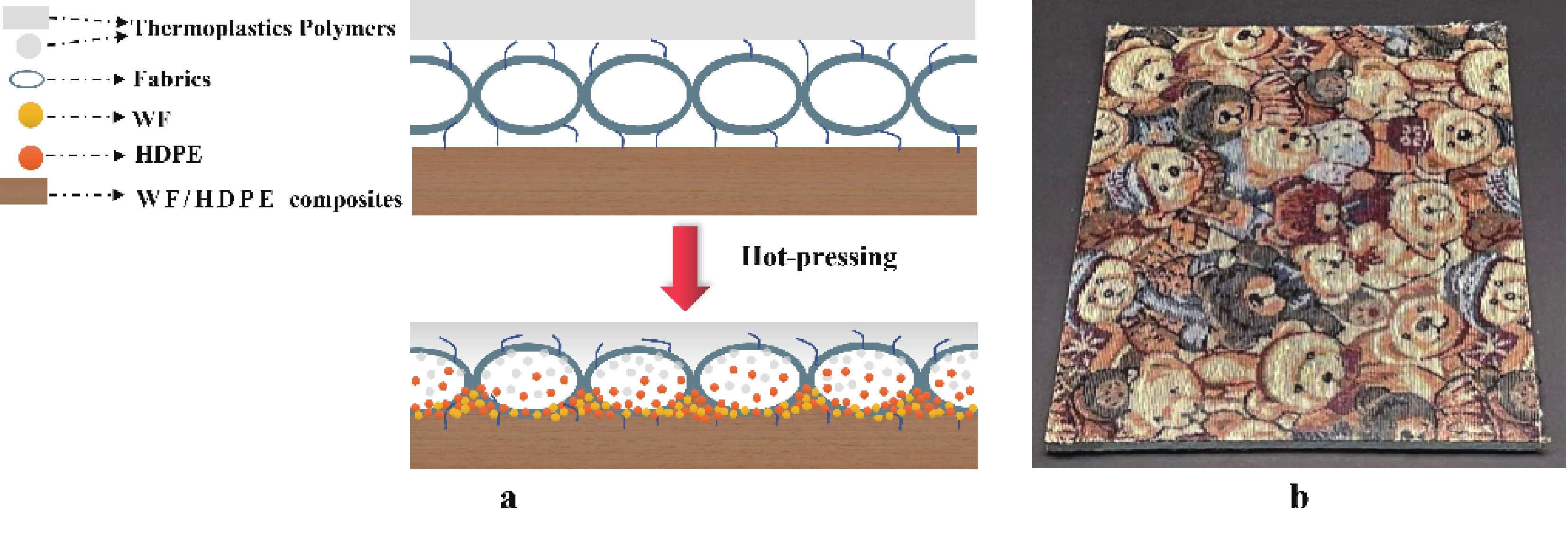
织物贴面WF/HDPE复合材料的界面结合机理示意图(a)及织物贴面木塑板(b)





 下载:
下载:







